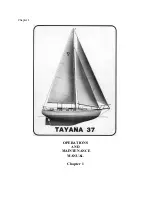
4
propel the vessel to about 7 knots in calm water at 2400 RPM. Your best cruising is at 2000 - 2200
RPM for longer periods.
Using higher throttle settings will produce very little increase in forward speed but will greatly
increase fuel and oil consumption and wear on the engine. For this reason, we ask that you limit the
use of higher power settings to real emergency situations.
This boat has a definite prop walk to the port in reverse with not much noticeable affect in forward.
She will move to starboard with slightly greater ease than to port at close quarters. When in reverse,
be careful to keep a firm grip on the wheel. Use only low RPMs.
Starting
To Start the Engine: Place the engine transmission in Neutral by positioning the shift lever straight
up. If you would like to increase engine speed out of gear, push the red button in to disengage the
propeller and advance the shift lever ahead slightly.
Start the engine by turning ignition to Exhaust Blower for 30 seconds then to start position. Do NOT
hold the key in the start position for more than 15 seconds at a time. If engine does not catch the first
time WAIT about 15 seconds before trying again.
Never turn off the key while the engine is
running.
You will do serious alternator damage. The key should remain on while the engine is
running.
Check the exhaust pipe
at the starboard stern for to ensure that water and exhaust are exiting while
the engine is running. This is as an indication that your engine seacock is open and water is keeping
your engine cool. If you do not see water coming out with the exhaust, see Seacocks above.
Normal cruising speed is 2000 to 2200 RPM.
Shutdown
Place the transmission in neutral and allow the engine to cool down for several minutes. Usually this
is about the amount of time it takes to secure your lines and plug into shore power. Push the stop
button located above the ignition key. This cuts off the fuel supply to the engine. Never turn off the
key while the engine is running. Alarms will sound until the key is switched off. Switch off the key
after engine has completely stopped.
Getting Underway
Disconnect the SHORE POWER CORD (See AC Power next page). Close the PORTHOLES,
WINDOWS, and FORWARD HATCHES. Turn on V.H.F. and electronics. Assign crewmembers to
their tasks. Put one crew member in charge of the dinghy, if it is under tow. It needs to be kept on a
tight leash when in the marina. Once outside marina, have crew members bring in fenders, put lines
away, and pay out extra dinghy tow line.
Docking
Have your crew make ready the lines and fenders and give clear instructions on how you will be
docking. Have bow, stern, and spring lines ready. Often times it is best to lead them to the mid
section of the boat (the fattest part) where your crew member can easily step off and secure lines.
Pull the dinghy up tight and make sure no lines are in the water that could foul the prop.




































